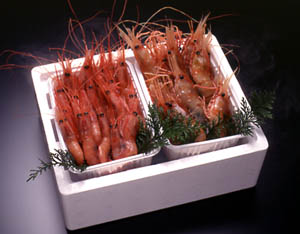I am not sure exactly which species of shrimp is called "amaebi" 甘エビ or sweet shrimp. As opposed to the regular shrimp you eat at sushi bars as sushi, served butterflied and boiled, "amaebi" is served raw. As a result, any kind of shrimp which is served raw appears to be called "amaebi". In the northernmost island of Japan, Hokkaido 北海道 where I am from, our "amaebi" was much larger than those in the rest of Japan. I am not sure if they are a different species or just larger versions of the same species. I initially thought that most of what is called "amaebi" in Hokkaido could be a type of "botanebi" ぼたんえび.
 But I found the picture on the left in a Japanese mail order place describing shrimp from Hokkaido and the caption read "...on the left are amaebi and on the right are botanebi..." and, further states "...many people mistake their amaebi as botanebi, since our amaebi are so big..." So, it appears that they are different when amaebi is more narrowly defined. I remember eating amaebi sushi in Tokyo for the first time (when I was in college). They put 2 or 3 amaebi shrimp to make one sushi. I was amazed since I was used to have one shrimp on one sushi; shrimp was more than big enough for one sushi in Hokkaido. In the U.S., there are at least two kinds of shrimp which are being distributed as "amaebi". We used to get "amaebi" from Alaska, twice a year. In spring, we got larger ones with spots on the side which must have been "spot prawns" (similar to "bontan-ebi") and, in fall, we got much smaller shrimp, which may have been "pink shrimp" (similar to "ama-ebi" in the narrow definition described above). We stopped getting these from this particular vendor in Alaska, though. The amaebi came in a plastic container already head removed. Sometimes they were good but many times they were just barely fresh enough to be eaten raw. Now, through Catalina offshore products, we, for the first time, got their "amaebi" or "spot prawns". Again, I am not sure if this is similar to what is called "botanebi" in Japan but they must be very simialr. Certainly, the size appeared very similar as well as the spots on the both sides of the body. They also look similar to what we used to get form Alaska in spring. According to Catalina, their spot prawns are caught in the water off San Diego and was kept alive in a tank until just before shipping, although they do not guarantee the shrimp to be alive upon receipt. They are large and quite fresh (they were not alive when we received them). So, we enjoyed them as a small sashimi and the head was deep fried. I trimmed the antennae and legs with a pair of kitchen scissors and dryed the head with a paper towel (it can splatter badly when deep fried). I deep fried them as is (without any flour or batter) in a medium hot (about 350F) oil for 5-7 minutes. I salted them lightly while they were hot.
But I found the picture on the left in a Japanese mail order place describing shrimp from Hokkaido and the caption read "...on the left are amaebi and on the right are botanebi..." and, further states "...many people mistake their amaebi as botanebi, since our amaebi are so big..." So, it appears that they are different when amaebi is more narrowly defined. I remember eating amaebi sushi in Tokyo for the first time (when I was in college). They put 2 or 3 amaebi shrimp to make one sushi. I was amazed since I was used to have one shrimp on one sushi; shrimp was more than big enough for one sushi in Hokkaido. In the U.S., there are at least two kinds of shrimp which are being distributed as "amaebi". We used to get "amaebi" from Alaska, twice a year. In spring, we got larger ones with spots on the side which must have been "spot prawns" (similar to "bontan-ebi") and, in fall, we got much smaller shrimp, which may have been "pink shrimp" (similar to "ama-ebi" in the narrow definition described above). We stopped getting these from this particular vendor in Alaska, though. The amaebi came in a plastic container already head removed. Sometimes they were good but many times they were just barely fresh enough to be eaten raw. Now, through Catalina offshore products, we, for the first time, got their "amaebi" or "spot prawns". Again, I am not sure if this is similar to what is called "botanebi" in Japan but they must be very simialr. Certainly, the size appeared very similar as well as the spots on the both sides of the body. They also look similar to what we used to get form Alaska in spring. According to Catalina, their spot prawns are caught in the water off San Diego and was kept alive in a tank until just before shipping, although they do not guarantee the shrimp to be alive upon receipt. They are large and quite fresh (they were not alive when we received them). So, we enjoyed them as a small sashimi and the head was deep fried. I trimmed the antennae and legs with a pair of kitchen scissors and dryed the head with a paper towel (it can splatter badly when deep fried). I deep fried them as is (without any flour or batter) in a medium hot (about 350F) oil for 5-7 minutes. I salted them lightly while they were hot.
This is excellent. The meat is fresh tasting and nicely sweet. The deep flied heads are a bit too large but crispy. Although you have to be careful how to chew this to avoid mouth injury, it was mighty good. With the delicate flavor of the shrimp, you have to have a cold sake.


No comments:
Post a Comment